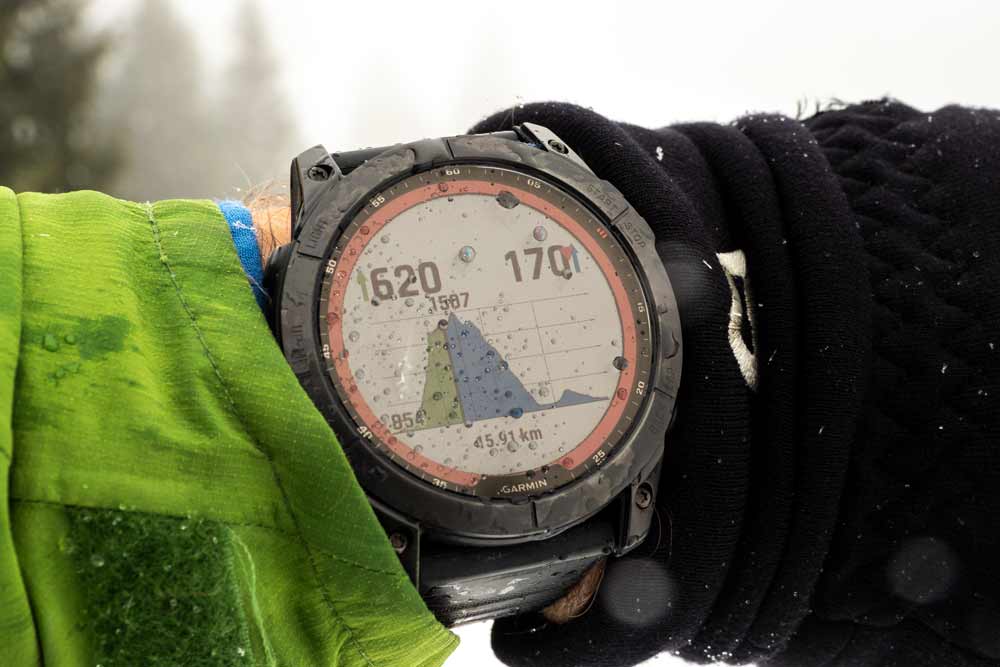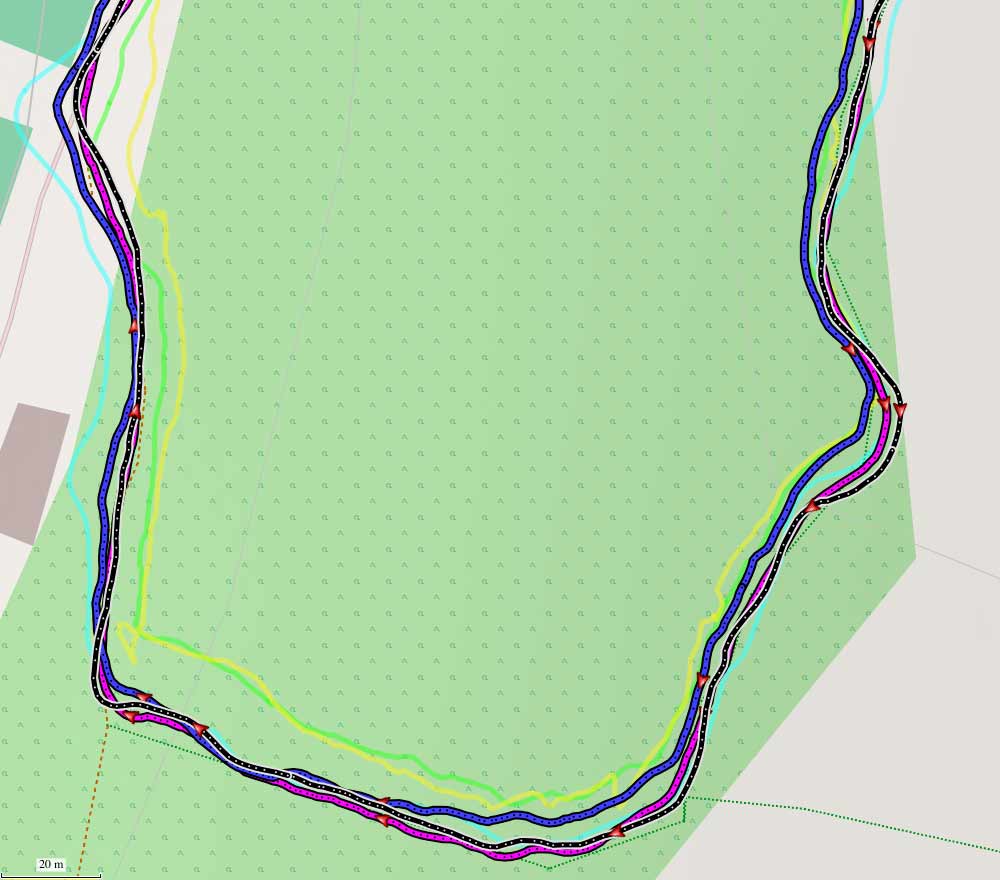The GPS accuracy of multisport watches and other GPS devices equipped with GPS receivers* is a frequently and controversially discussed topic!
*Actually it should read 2022 GNSS accuracy, GNSS receivers or GNSS devices respectively; but GPS is commonly used.
Before I get into the GPS accuracy of the fenix 7 and epix, a bit of history.
Some users certainly remember the days when GPS devices were equipped with receivers that could only use signals from the American Navstar GPS system. Position deviations of well over 100 m were quite possible in the early days, for example in the mountains.
A technological leap was the introduction of a second GNSS (= Global Navigation Satellite System): GPS devices could now evaluate the signals of a second system – usually from the Russian GLONASS. This has led to a significant improvement in GPS accuracy. In addition, position determinations are faster. The next steps were to evaluate signals from the European GALILEO and the Chinese BEIDOU system.
This development is well demonstrated by the Garmin fenix series and the Garmin epix. The individual generations offer the following GNSS settings:
- fenix (2012): GPS
- fenix 2 (2014): GPS
- fenix 3 (2015): GPS, GPS + GLONASS
- fenix 5 (2015): GPS, GPS + GLONASS, GPS + GALILEO*
- epix (2015): GPS, GPS + GLONASS
- fenix 6 (2019): GPS, GPS + GLONASS, GPS + GALILEO
*GALILEO has been added in 2020 as part of an update.
In 2022, Garmin goes a big step further. The new Garmin fenix 7 series – the same applies to the Garmin epix 2 – can now evaluate satellite signals from several GNSS: BEIDOU (China), GALILEO (Europe), GLONASS (Russia), GPS (USA), QZSS (Japan). In addition, some models have a multi-band reception of satellite signals on different frequencies.
I do not want to go into details here. The GNSS settings for a fenix 7X Sapphire Solar & a Garmin epix are shown in the overview below.
I also recommend the following articles: Why Multi-band? Q&A with Garmin Engineer Jared Bancroft or Dual Frequency Q&A (PDF).
What does this progress mean in outdoor practice? Are GPS accuracies really better?

Garmin fenix 7 & epix Gen 2 GPS Accuracy – Review Participants
In the comparison, various current devices are used – including the Nokia XR20 outdoor smartphone and my previous (!) reference system, the Garmin GPSMAP 66sr outdoor handheld. The exclamation mark already reveals something about the review result …!
The epix 2 is in many cases identical to the fenix 7X Sapphire Solar used for the test; the results should therefore also apply to the epix Gen 2.
GNSS Settings
Garmin fenix 6X Pro
- GPS
- GPS + GLONASS
- GPS + GALILEO
- UltraTrac
Garmin fenix 7X Sapphire Solar
- GPS
- GPS + GLONASS + GALILEO + BEIDOU + QZSS*
- GPS + GLONASS + GALILEO + BEIDOU + QZSS* + Multi-Band
- UltraTrac
Garmin epix
- GPS
- GPS + GLONASS + GALILEO + OZSS* + IRNSS*
Coros Pace 2
- GPS
- GPS + GLONASS + GALILEO + QZSS*
- GPS + BEIDOU + GALILEO + QZSS*
- UltraMax
Coros Apex Pro
- GPS
- GPS + GLONASS + GALILEO + QZSS*
- GPS + BEIDOU + GALILEO + QZSS*
- UltraMax
TicWatch Pro 3 Ultra 4G / Amazfit GTS 3
- GPS + GLONASS + GALILEO + BEIDOU + OZSS*
Polar Grit X Pro
- GPS + GLONASS
- GPS + GALILEO
- GPS + QZSS*
Suunto 9 Peak
- GPS + QZSS*
- GPS + QZSS* + GLONASS
- GPS + QZSS* + GALILEO
- GPS + QZSS* + BEIDOU
Nokia XR20 (rugged smartphone)
- GPS + GLONASS + GALILEO + BEIDOU + QZSS* + IRNSS* + Multi-Band
Garmin GPSMAP 66sr (handheld)
- GPS
- GPS + GLONASS + GALILEO + OZSS* + IRNSS*
- GPS + GLONASS + GALILEO + OZSS* + IRNSS* + Multi-Band
*regional systems
Interactive map for reviewing the quality of activity recordings
- Colors: To display the color coding, move the mouse pointer to "Tracks"; individual tracks can also be hidden there.
- Multi-GNSS: Devices with more than three GNSS.
- GNSS used: Noted under "Tracks".
- Elevation: Each device was manually calibrated prior to the tests.
- Use "Select" to display a course.
- Select a map via the layer icon (right).
- Since extensive original files are used, the loading can take.
- It is recommended to select only the devices in focus via "Tracks"; this makes interpretation easier.
Garmin fenix 7 & epix Gen 2 GPS Accuracy – Results & Interpretation
Courses 1 – 4
These small courses should help to get a first impression. However, the results are already quite clear.
- Courses 2 + 4, multi-band was turned off on fenix 7X Sapphire Solar
- Course 5, there’s a small swerve in the last section because I’ve rushed past the turn; so be careful when interpreting.
What shows up?
- Devices with multiple GNSS & multi-band show the best, consistent and reproducible results (fenix 7X, XR20, GPSMAP 66sr).
- The fenix 7 is at least on par with the GPSMAP 66sr.
- With or without multi-band, no differences can be seen on the fenix 7X.
- Devices with only two GNSS deliver significantly more choppy tracks with larger deviations (Garmin fenix 6X Pro, Polar Grit X Pro, Suunto 9 Peak).
- The Apex Pro and the Pace 2 from Coros deliver (almost) equal records to the fenix 7X, XR20 and GPSMAP with multiple GNSS.
The following image shows a typical section (course 1, all devices with the best GNSS settings).

Courses 5 – 6
Now it’s getting interesting! The small courses in the city center of Munich should provide further insights, especially on the subject of multi-band (reflections of the satellite signals by buildings and pavement).
When walking, I always kept as close as possible to the house fronts – to challenge the devices; the blue waypoints provide information on the respective sides of the street.
- My favourites fenix 7X, GPSMAP 66sr and XR20 again tend to show the best results.
- The fenix 7X delivers a better result with multi-band (course 1 on, course 2 off). The same is true for the GPSMAP 66sr. However, a few more rounds would be necessary to verify this … let’s see!
- Devices with only two GNSS deliver significantly more choppy tracks with much larger deviations (Polar Grit X Pro, Suunto 9 Peak).
- If the additional GNSS are switched off on all devices (GPS only mode), the results turn out "catastrophic" for the most part (course 3).
- The TicWatch Pro 3 Ultra delivers a miserable result despite several GNSS; there are just more factors than the GNSS used that play a role (course 2).
- The tracks tend to be shifted towards the other side of the road (good to see in course 3).
In the mountains
Result: In the future, my previous reference device can stay at home, a fenix 7X Sapphire Solar will take over this task. The recordings also meet the highest standards.
Tour 5 + Tour 7 show a comparison fenix 7 with multi-band vs. epix without multi-band – the tracks show practically no differences, the accuracy is just fabulously good!
The same is true for Tour 6. At one point (marked on the map by a waypoint), the fenix 7X worn on the right arm drifted a bit in the direction of the slope (the slope is on the right side in the direction of descent). Since I have noticed this at this point before, I suspect that the combination of "right arm & snowy slope right" leads to this slight drift.
- Marke: Garmin
fenix 7 & epix GPS Accuracy Review – Conclusion
I think the result is clear: The fenix 7X Sapphire Solar and the epix deliver outstanding GPS accuracy. I have yet to see anything better in wearables (possibly the Coros Vertix 2 will pull even, we’ll see).
Competitors have to measure themselves against the accuracy of the fenix 7 series and epix series. For this reason alone, I assume that we will only see GPS receivers with more than two GNSS in mid- to high-priced wearables in the future. Multi-band is likely to establish itself as another option, especially since numerous smartphones already rely on this technology.
Do you need multi-band?
I mean it is not absolutely necessary, unless you are often in challenging environments or simply want the best!

Since GPS frequencies produce wave lengths of around 25-30 cm, I wonder if there is any significant difference in GPS accuracy between a fenix 7x (best) to a fenix 7s (worst)?
On the maps, can you add a line of where you ACTUALLY went?
No. To do that you need a GPS device!
hi, so the garmin edge 830 will also not be so accurate?
Hi, I will check it in the next weeks; but you can compare Edge cycling devices with the GPSMAP 66sr handheld (multi-GNSS, multi-band):
https://www.navigation-professionell.de/en/gps-accuracy-cycling-devices/
How do you know that Beidou is supported in Garmin dual-freq devices? As I can not find any Beidou wording in official documents and web pages. Please help to clarify this missing information. Thank you.
I saw it on a presentation from Garmin, check:
Those are some awesome results! In terms of GPS accuracy, do you know how the Forerunner 945 will be compared to the Fenix 7 and Apex Pro?
Hi,
I do not have the Forerunner here and can not compare.
I don’t have the Forerunner 945 either, so cannot compare it from my own experience. However, I would assume that it is similar in terms of accuracy to the Fenix 6 series. I recommend that you double-check this: just google some comparisons of the F945 to the F6 – and then you can extrapolate your own conclusions to the Fenix 7 🙂